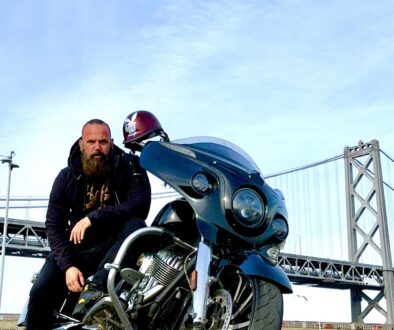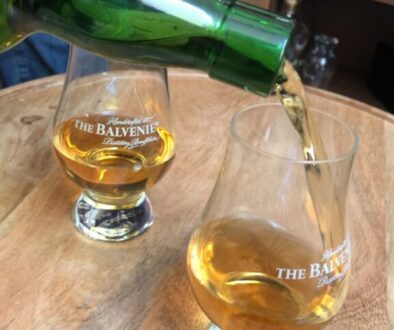Green Beer, Parades, and a Not-So-Irish Saint
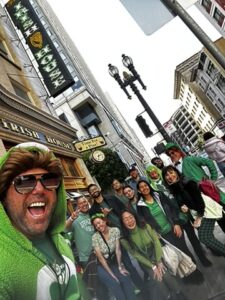 March 17—a day when green, green beer, redheads, and shamrocks rule, and suddenly everyone you meet claims to have some percentage of Irish blood. I’m talking about the St. Patrick’s Day Parade. It’s a day of dancing, drinking, kissing, and maybe even fighting—only to make up over a pint. But where does all of this madness come from? Ireland, right? Not exactly.
March 17—a day when green, green beer, redheads, and shamrocks rule, and suddenly everyone you meet claims to have some percentage of Irish blood. I’m talking about the St. Patrick’s Day Parade. It’s a day of dancing, drinking, kissing, and maybe even fighting—only to make up over a pint. But where does all of this madness come from? Ireland, right? Not exactly.
Recently, I took a group of people on a pub crawl for San Francisco’s 147th St. Patrick’s Day Parade. Try saying that three times fast after a few Irish Car Bombs! Naturally, I dove into research mode, soaking up everything I could about St. Patrick’s Day. What I found: Saint Patrick was not Irish, he’s not a “real” saint, and the parades didn’t originate in Ireland. I know—mind blown!🤯
About This Dude Named Patrick
Saint Patrick was born in Roman Britain, and at the age of 16, he was captured by Irish raiders and enslaved in Ireland. Yep, he was English, all right. During his six years of captivity, far from home, family, and his old traditions, he absorbed Irish culture while spending long hours as a sheep herder.
One day, a voice in his head told him it was time—time to escape and make the 200-mile journey to the shore, where he managed to find a boat back to England. Once home, the same voice led him to spend the next 15 years studying Christianity and becoming a missionary. Then, the voice told him to return to Ireland. And he did.
Patrick the Saint
When Patrick returned to Ireland to do missionary work for the Catholic Church, he was credited with introducing Christianity to the country. Some argue that other missionaries were already doing this before him, but it was Saint Patrick who cemented Christianity in Irish culture.
One of his most famous acts was fasting for 40 days on Croagh Patrick, a sacred Irish mountain with a history of pilgrimage dating back over 5,000 years—long before Christianity even arrived.
Folklore tells us that Saint Patrick drove all the snakes out of Ireland. But here’s the thing—Ireland never had snakes to begin with. The cold waters surrounding the island made sure of that. More likely, the “snakes” were a metaphor for pagan practices, which Patrick worked to replace with Christianity.
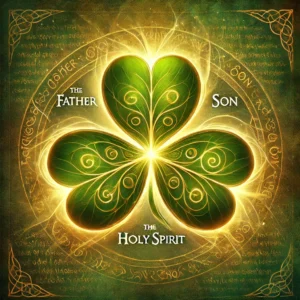 He also used the shamrock to explain the Holy Trinity—the Father, the Son, and the Holy Spirit—turning it into a symbol of Irish Christianity. People started wearing shamrocks on their lapels, and later, dressing in green to honor his work. That’s how green became the go-to color for St. Patrick’s Day celebrations.
He also used the shamrock to explain the Holy Trinity—the Father, the Son, and the Holy Spirit—turning it into a symbol of Irish Christianity. People started wearing shamrocks on their lapels, and later, dressing in green to honor his work. That’s how green became the go-to color for St. Patrick’s Day celebrations.
When Saint Patrick died on March 17, 461 AD, the Catholic Church didn’t have an official process for canonization. The first official saint, St. Ulrich of Augsburg, wasn’t canonized until 993 AD. So technically, Saint Patrick was never formally recognized as a saint by the Vatican. Instead, he was made a saint by popular demand—a true people’s saint.
Despite never being officially canonized, Saint Patrick is recognized as Ireland’s patron saint and is widely venerated by the Catholic Church, the Lutheran Church, the Church of Ireland, and the Eastern Orthodox Church.
Dancing, Drinking, & Parades 🍀🎭🍻
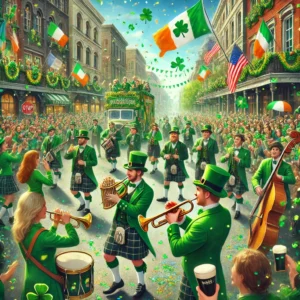 In Ireland, the Catholic Church observes March 17th as the Feast Day of St. Patrick, believed to be the date of his death. The key phrase here is feast day, and it lands right in the middle of Lent—a 40-day period of reflection, repentance, and spiritual preparation for Easter. If this sounds familiar, it should—just like Mardi Gras (Fat Tuesday) marks the last big celebration before Lent begins, St. Patrick’s Day offers a mid-Lent reprieve, a reason to gather, eat, drink, and celebrate. And what better way to do that than with music, dancing, and parades?
In Ireland, the Catholic Church observes March 17th as the Feast Day of St. Patrick, believed to be the date of his death. The key phrase here is feast day, and it lands right in the middle of Lent—a 40-day period of reflection, repentance, and spiritual preparation for Easter. If this sounds familiar, it should—just like Mardi Gras (Fat Tuesday) marks the last big celebration before Lent begins, St. Patrick’s Day offers a mid-Lent reprieve, a reason to gather, eat, drink, and celebrate. And what better way to do that than with music, dancing, and parades?
Leaving behind famine and hardship, Irish immigrants in San Francisco celebrated the city’s first St. Patrick’s Day parade in 1851. However, the first recorded St. Patrick’s Day celebration in America dates back even further—to 1601 in Spanish-ruled Florida. The first unofficial “parade” happened in Boston in 1737, when a group of Irish immigrant workers took to the streets, singing in Gaelic on their way to a local Irish bar. But it was in New York in 1762 that the first official St. Patrick’s Day parade took place.
While Boston throws a hell of a party and Chicago dyes its river green every year, New York still hosts the largest St. Patrick’s Day parade in the world.
Ireland, on the other hand, didn’t have its first official parade until 1903 in Waterford. Dublin followed in 1931, but it wasn’t until 1995 that Ireland truly embraced St. Patrick’s Day as a major event—mainly as a way to attract tourists.
So, while St. Patrick’s Day started as a religious feast, it was the 31.5 million Irish-Americans and Irish immigrants who turned it into the massive celebration we know today.
Final Toast
 After leading that wild pub crawl, I realized St. Patrick’s Day isn’t just about where you’re from—it’s about where you are and who you celebrate with. So whether you’re Irish by birth or just by beer choice, raise a glass, dance a jig, and enjoy the madness.
After leading that wild pub crawl, I realized St. Patrick’s Day isn’t just about where you’re from—it’s about where you are and who you celebrate with. So whether you’re Irish by birth or just by beer choice, raise a glass, dance a jig, and enjoy the madness.
Sláinte! 🍻
PS: The Irish Car Bomb Cocktail
The “Irish Car Bomb” cocktail, despite its name, originated in the United States in 1979 at Wilson’s Saloon in Norwich, Connecticut. It was invented by Charles Burke Cronin Oat, who spontaneously dropped a shot of Baileys and Jameson into a pint of Guinness, calling the result a “Belfast Carbomb” or “Irish Carbomb.” While the drink remains popular, its name is controversial due to its reference to the violent history of The Troubles in Ireland. Still, for better or worse, it remains a St. Patrick’s Day staple in bars across America.


 March 17—a day when green, green beer, redheads, and shamrocks rule, and suddenly everyone you meet claims to have some percentage of Irish blood. I’m talking about the St. Patrick’s Day Parade. It’s a day of dancing, drinking, kissing, and maybe even fighting—only to make up over a pint. But where does all of this madness come from? Ireland, right? Not exactly.
March 17—a day when green, green beer, redheads, and shamrocks rule, and suddenly everyone you meet claims to have some percentage of Irish blood. I’m talking about the St. Patrick’s Day Parade. It’s a day of dancing, drinking, kissing, and maybe even fighting—only to make up over a pint. But where does all of this madness come from? Ireland, right? Not exactly. He also used the shamrock to explain the Holy Trinity—the Father, the Son, and the Holy Spirit—turning it into a symbol of Irish Christianity. People started wearing shamrocks on their lapels, and later, dressing in green to honor his work. That’s how green became the go-to color for St. Patrick’s Day celebrations.
He also used the shamrock to explain the Holy Trinity—the Father, the Son, and the Holy Spirit—turning it into a symbol of Irish Christianity. People started wearing shamrocks on their lapels, and later, dressing in green to honor his work. That’s how green became the go-to color for St. Patrick’s Day celebrations. In Ireland, the Catholic Church observes March 17th as the Feast Day of St. Patrick, believed to be the date of his death. The key phrase here is feast day, and it lands right in the middle of Lent—a 40-day period of reflection, repentance, and spiritual preparation for Easter. If this sounds familiar, it should—just like Mardi Gras (Fat Tuesday) marks the last big celebration before Lent begins, St. Patrick’s Day offers a mid-Lent reprieve, a reason to gather, eat, drink, and celebrate. And what better way to do that than with music, dancing, and parades?
In Ireland, the Catholic Church observes March 17th as the Feast Day of St. Patrick, believed to be the date of his death. The key phrase here is feast day, and it lands right in the middle of Lent—a 40-day period of reflection, repentance, and spiritual preparation for Easter. If this sounds familiar, it should—just like Mardi Gras (Fat Tuesday) marks the last big celebration before Lent begins, St. Patrick’s Day offers a mid-Lent reprieve, a reason to gather, eat, drink, and celebrate. And what better way to do that than with music, dancing, and parades? After leading that wild pub crawl, I realized St. Patrick’s Day isn’t just about where you’re from—it’s about where you are and who you celebrate with. So whether you’re Irish by birth or just by beer choice, raise a glass, dance a jig, and enjoy the madness.
After leading that wild pub crawl, I realized St. Patrick’s Day isn’t just about where you’re from—it’s about where you are and who you celebrate with. So whether you’re Irish by birth or just by beer choice, raise a glass, dance a jig, and enjoy the madness.